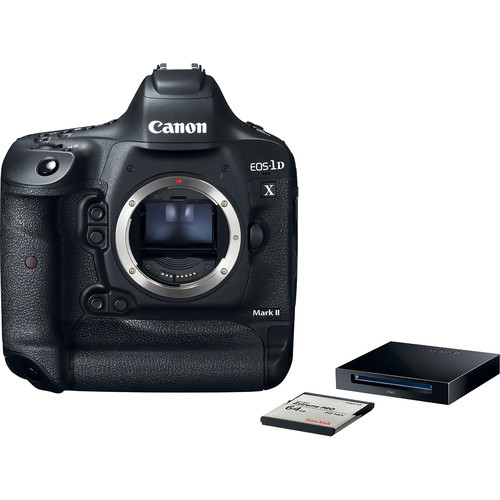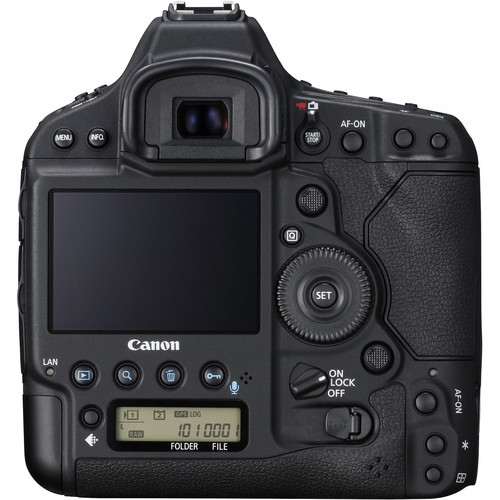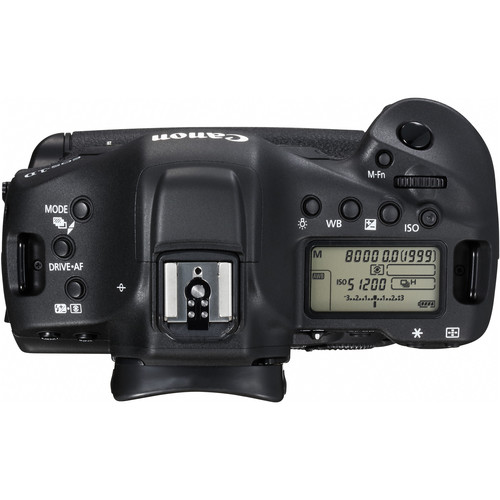
Canon EOS-1D X Mark II DSLR Camera Premium Kit (body only $5999)
Product Highlights
As a 1DX owner, I’ve been eager to see what Canon came up with for the replacement to my camera. Now the wait is over, and it’s official. Here’s the highlights of what’s included:
-
Newly developed 20.2 megapixel 35mm Full Frame Canon CMOS sensor;
-
Continuous shooting speeds of up-to-14 frames per second (fps) with Auto Exposure (AE) and predictive AF for viewfinder shooting and up to 16 fps1 in Live View mode;
-
Dual DIGIC 6+ Image Processors that transfer image data at extremely high speed for extended bursts during continuous shooting – up-to-170 consecutive RAW images at 14 fps. When shooting JPEG images you’re only limited by memory card capacity 2;
-
Capable of shooting 4K 60P and Full HD 120P video with Dual Pixel CMOS AF;
-
Enhanced wireless functionality (with the optional accessory Wireless File Transmitter WFT-E8) that supports the new high-speed IEEE 802.11ac standard and the ability to easily transfer photos and videos to compatible smartphones using Canon’s Camera Connect app*;
-
Digital Lens Optimizer to help correct aberrations in-camera (a feature that previously required post-processing on an external computer);
-
Improved 61-point viewfinder AF with expanded coverage and all AF-points selectable and supported to a maximum aperture of f/8;
-
Improved AI Servo III+ predictive AF algorithm for better accuracy;
-
Continuous red illumination of all AF points within the camera’s Intelligent Viewfinder II.
-
Compatibility with both CF and CFast memory cards for optimal performance and versatility.
Estimated ship date is 4/29/16. For a complete list of accessories CLICK HERE.
Compare the 1DX Mark II to other Canon DSLR’s and its predecessor using this awesome PDF.
If you are curious as to how that compares to the D5, then here’s the highlights for the D5:
- 20.8MP FX-Format CMOS Sensor
- EXPEED 5 Image Processor
- 3.2" 2.36m-Dot Touchscreen LCD Monitor
- 4K UHD Video Recording at 30 fps
- Multi-CAM 20K 153-Point AF System
- Native ISO 102,400, Extend to ISO 3,280,000!!!
- 12 fps Shooting for 200 Shots with AE/AF
- 180k-Pixel RGB Sensor and Group Area AF
- 14-Bit Raw Files and 12-Bit Raw S Format
- 1000 Base-T Gigabit Wired LAN Support
- Available in dual XQD or CF only versions (woohoo, they listened!)
See more in my D5 article.
Ron’s Take

Canon EOS-1D X Mark II Rear View
Physically not much has changed beyond the greater resolution touch screen, and that’s a good thing as the 1D X body was very well designed. It’s also tough to re-learn a new body, especially if you keep your old body so I was glad for things to stay the same.
While some may be dissapointed that this wasn’t some 50+MP camera, I’m personally glad to see the 20.2MP sensor that should be on par or better than the D5. Hopefully this “newly developed” sensor will have the dynamic range and high ISO quality that meets or exceeds Nikon’s for the ISO they both offer. I was very dissapointed that Canon did match Nikon’s 153-point AF system and native 102,400 ISO, so I’m on the fence about what I’ll do next.
It also would have been a welcome addition to have the D5’s 2.3m dot touchscreen vs Canon’s 1.62m – especially when zooming in live view for critical focusing, so I’m dissapointed Canon didn’t do more for the LCD – especially given the price!
I’m eager to see how the new AF system works as the 1D X was a great improvement over its predecessors and the Nikon D4, but no match for the incredible performance of the D4s. The D5 is expected to top the D4s, so it should be very interesting to see how these to compete against each other. On paper Nikon should be the winner, but Canon’s better lens line up – including the amazing Canon 200-400mm f/4L IS with 1.4X Extender should prove a tough decision for wildlife and sports photographers.
I’ll test them both for sure and let you know what I think!
B&H First Look Video
More from the Press Release

Canon EOS-1D X Mark II Top View
The Ultimate EOS Camera: Continuing a Legacy of High Speed and Performance
Building on the success of the Canon EOS-1D X professional digital camera, the Canon EOS-1D X Mark II camera is designed to deliver high-performance, speed, and image quality, with improved comfort for professional photographers. In addition to the new 20.2 megapixel full-frame CMOS sensor and Dual DIGIC 6+ Image Processors, the new EOS-1D X Mark II DSLR camera includes an improved 61-point High-Density Reticular AF II system with all AF points selectable by the user (and up to 41 cross-type points depending on the lens in use). The improved AF system includes expanded coverage that supports AF at maximum apertures up to f/8 with all 61 points for high precision autofocus even when using EF super-telephoto lenses with an EF extender. The camera also boasts excellent dynamic range and reduced color noise compared to its predecessor throughout its standard ISO speed range of 100 - 51,200. Expansion ISO speeds of 50, 102,400, 204,800 and 409,600 are also available. A first for the Canon EOS-1D series, this camera also features a 360,000-pixel RGB+IR metering sensor with enhanced precision and performance compared to its predecessor, improving facial recognition and tracking, as well as nature scenes. Additionally, the advanced AE system can detect and compensate for flickering light sources such as sodium vapor lamps that are often used in gymnasiums and swimming pools. When enabled, this anti-flicker system automatically adjusts shutter release timing to help reduce disparities in exposure and color especially during continuous burst shooting.
For filmmakers and photographers looking to do more than still photography alone with a DSLR camera and EF lenses, the EOS-1D X Mark II camera offers high resolution DCI 4K video at frame rates up-to-60p, with smooth movie recording to an in-camera CFast 2.0 memory card. An additional card slot supports standard CF memory cards up to UDMA 7. The built-in headphone jack supports real-time audio monitoring. Two additional EOS ‘firsts’ include 4K Frame Grab and 120p Full HD recording. The camera’s 4K Frame Grab function allows users to isolate a frame from recorded 4K video and create an 8.8 megapixel still JPEG image in-camera. When combined with the EOS-1D X Mark II’s high-sensitivity full-frame CMOS sensor, the new camera’s ability to record Full HD video at frame rates up to 120p will allow videographers to produce high quality slow motion video even in extremely low light. To make video shooting even more intuitive, the Canon EOS-1D X Mark II camera’s touch-screen LCD allows videographers to select the camera’s AF point before and during video recording with Dual Pixel CMOS AF, which provides responsive, accurate and quiet camcorder-like video autofocus to DSLRs.
“The innovations within Canon’s new EOS-1D X Mark II DSLR camera clearly set a new standard for professional cameras,” said Yuichi Ishizuka, president and COO, Canon U.S.A., Inc. “In developing the EOS-1D X Mark II camera, we looked to incorporate user-requested performance enhancements to bring professional photographers the ultimate EOS camera, a camera that has matured and been developed to meet their evolving needs.”
“Having f/8 capability on all 61 AF points is a tremendous benefit to wildlife photographers," noted nature photographer and Canon Explorer of Light Charles Glatzer. “In order to capture tight shots of animals without disturbing them, I frequently have to use very long lenses—sometimes with an extender attached, which further diminishes the aperture. The improved AF allows me to frame the shot exactly the way I envision it, without having to compromise.”
“This camera is a huge step forward,” remarked acclaimed photographer and Canon Explorer of Light Damian Strohmeyer. “Shooting sports in a gym at 8,000 ISO, it looked as good as 800 ISO from a generation or two ago. The images are tack-sharp, and the autofocus just doesn't miss. I've been amazed by what I've seen so far.”
“The autofocus was awesome,” agreed Peter Read Miller, sports photographer and Canon Explorer of Light. “The higher frame rate coupled with the speed of the CFast card was a definite advantage. It just never buffered out, even shooting RAW.”
The new EOS-1D X Mark II camera also offers a built-in GPS** receiver with compass for precise geo-tagged information of latitude, longitude, elevation and direction. This is especially valuable to wildlife photographers and photojournalists who need to track their locations, as well as providing sports photographers the ability to sync a multiple-camera setup with extreme accuracy and precision. It is also possible to use the camera’s built-in GPS to automatically sync the camera’s time to the atomic clock, an invaluable feature to professionals. An improved grip also makes the camera easier for photographers to hold and maneuver while shooting. In response to feedback from professional EOS users, the AF points in the EOS-1D X Mark II camera’s Intelligent Viewfinder II can be illuminated in red for improved visibility, especially when shooting in dark locations. AF sensitivity in low light has been doubled from EV -2 to EV -3 at the center AF point when the camera is set to One-Shot AF, enabling the camera to autofocus in extremely dark shooting conditions such as a moonlit nightscape. Viewfinder AF coverage has also been increased for greater compositional flexibility.
As with all EOS-1D series cameras, the EOS-1D X Mark II’s rugged construction and magnesium alloy body is weather resistant. The camera also features improved controls and more in-camera image quality enhancements than ever before, including a Digital Lens Optimizer function offering high quality aberration correction which can now be achieved without an external computer. This feature makes it easier for professional photographers to deliver finished files to their clients, especially in situations when access to a personal computer is impractical or inconvenient.
The estimated retail price for the Canon EOS-1D X Mark II is $5999 (MSRP) for the body or $6299 for the Premium Kit which includes a 64 GB CFast memory card and card reader. The new camera is scheduled to begin shipping to authorized Canon USA dealers in April 2016***. For more information and the full list of product specifications, visit: usa.canon.com/EOS1DXMarkII
Click here to see the full press release.
Where to order
Click here to learn more about this camera and all of the options available for it at B&H. Adorama is also taking pre-orders here (premium kit here).
Other articles you may enjoy
If you enjoyed this article, you may also enjoy these:
- Nikon D5, D500 & SB-5000 Speedlight CES Preview
- Canon 600EX-RT Flash First Look (ST-E3 RT)
- Canon 11-24mm f/4L
- Canon 16-35mm f/4L vs 16-35mm f/2.8L II
- Canon 24-70 f/2.8L II (vs 24-70 f/4L IS Comparison)
- Canon 70-200mm f/2.8L IS II USM First Look
- Canon 70-300mm f/4-5.6L IS vs 70-300 f/4.5-5.6 DO
- Canon 100-400m f/4.5-5.6L IS II USM (NEW)
- Canon 200-400mm f/4L IS with 1.4X Extender
- Canon 300mm f/2.8L IS II at the Zoo
- Epson SureColor P600 Printer Review
- Epson SureColor P800 Review
- NEC PA322UHD 4k for Pro Photo & Video Editing
- SIGMA 120-300mm
- SIGMA 24mm Art Series
- SIGMA 35mm Art Series
- SIGMA 50mm f/1.4 Art Series (includes comparisons)
- SIGMA 85mm f/1.4 EX DG
- Sony a7R Mark II with 24-70mm
- Ron’s Recommendations
Disclosure
If you make a purchase using links found in this article, I may make a commission. It doesn’t cost you a penny more, but it does help to support future articles like this.






























